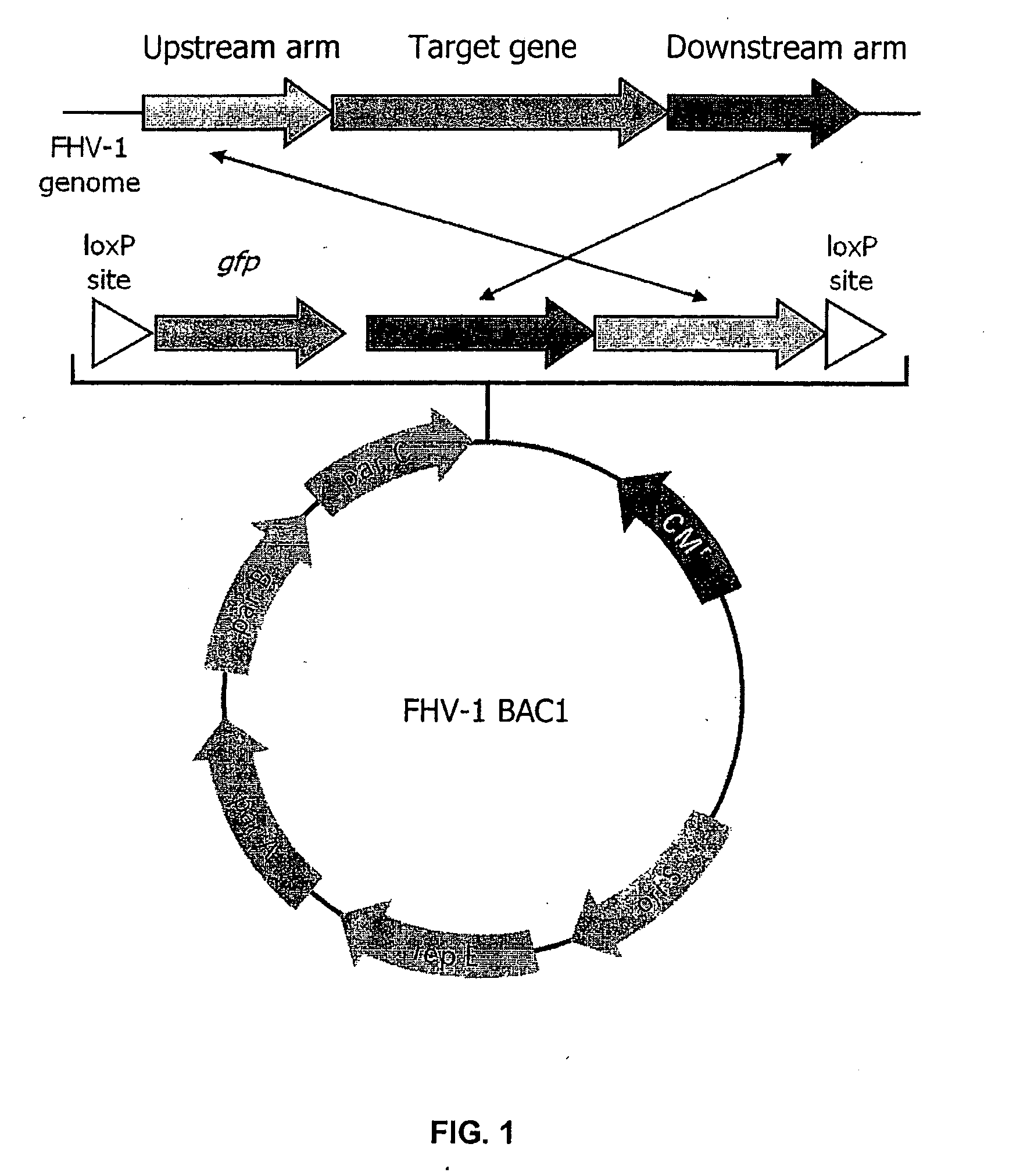Bacterial Artificial Chromosome Containing Feline Herpes Virus Type 1 Genome and Uses Thereof
a technology of feline herpes virus and artificial chromosome, which is applied in the field of recombinant feline herpes virus type 1 (fhv1) nucleic acids and proteins, can solve the problem that the immune system induced by existing commercial vaccines cannot completely protect cats from field virus infection, and achieve the effect of fast and efficient manipulation of bac clones
- Summary
- Abstract
- Description
- Claims
- Application Information
AI Technical Summary
Benefits of technology
Problems solved by technology
Method used
Image
Examples
example 1
Construction of Infectious FHV-1 BAC Clones
[0121]Overview. BAC vectors containing the pBeloBAC11 (Invitrogen) backbone, chloramphenicol resistance gene, gfp gene, and targeting homologous regions were constructed. Purified FHV-1 viral genome and BAC vector DNA were co-transfected into Crandell Reese feline kidney (CRFK) cells by electroporation. Homologous recombination takes place in the CRFK cells resulting in replacement of the targeted FHV-1 gene with the BAC plasmid. Under selection, replication of nonrecombinant viral genomes was suppressed. Recombinant viruses, which produce fluorescent plaques, were isolated by plaque purification. Recombinant viral genomes were propagated in the CFRK cells, and as a natural process of herpesvirus replication, the viral genome becomes circularized. DNA was extracted from transfected cells when clear plaques were observed. Extracted DNA was transferred into E. coli DH10B electrocompetent cells, which are defective in the RecABCD recombination...
example 2
FHV-1 Genome Sequencing and Gene Annotation
[0127]Overview. The recombinant virus clone #11A1-01 isolated as described in Example 1 was propagated in CRFK cells, and then used to infect CRFK monolayers. The circular form of the genomic DNA was extracted from infected cells and used to transform E. coli. Bacterial colonies containing the FHV-1 BAC DNA were extracted from the bacterial cells. The FHV-1 BAC DNA was digested with different restriction enzymes to analyze the integrity of the clone. The digested FHV-1 BAC DNA was separated in agarose gels, and transferred onto nylon membranes. The Southern blots were probed with labeled DNAs targeting the BAC backbone plasmid components. FHV-1 BAC DNA extracted from bacterial cells was also transfected into CRFK cells to demonstrate its ability to producing viral particles in vitro. After the genomic integrity and in vitro replication capacity of the FHV-1 BAC DNA were confirmed, the FHV-1 BAC clone was subjected to whole genome sequencing...
example 3
Generation of gG−, gE− and gG− / gE− FHV-1 Mutants
[0133]Overview. The E. coli strain SW105, which is capable of recombineering, is made electrocompetent and transformed with FHV-1 BAC DNA. A site-specific mutagenesis procedure with a two step galK selection (Warming et al., Nucleic Acids Res, 33:e36, 2005) is employed to produce gG−, gE− and gG− / gE− mutants. In the first round of homologous recombination, the targeted sequence is replaced with a galK expression cassette, producing bacteria that are phenotypically Gal+. Positive selection for galK expression is applied. In the second round, the galK cassette is completely removed, producing bacteria that are phenotypically Gal-. Negative selection for galK expression is then applied. Immediately after each step of selection, mini-preps of BAC DNA are prepared and analysed by restriction endonuclease digestion and Southern blot hybridization. Successfully engineered BAC clones, verified by the presence of the expected restriction patter...
PUM
| Property | Measurement | Unit |
|---|---|---|
| temperature-sensitive | aaaaa | aaaaa |
| temperature-sensitive | aaaaa | aaaaa |
| temperature | aaaaa | aaaaa |
Abstract
Description
Claims
Application Information
 Login to View More
Login to View More - R&D
- Intellectual Property
- Life Sciences
- Materials
- Tech Scout
- Unparalleled Data Quality
- Higher Quality Content
- 60% Fewer Hallucinations
Browse by: Latest US Patents, China's latest patents, Technical Efficacy Thesaurus, Application Domain, Technology Topic, Popular Technical Reports.
© 2025 PatSnap. All rights reserved.Legal|Privacy policy|Modern Slavery Act Transparency Statement|Sitemap|About US| Contact US: help@patsnap.com



